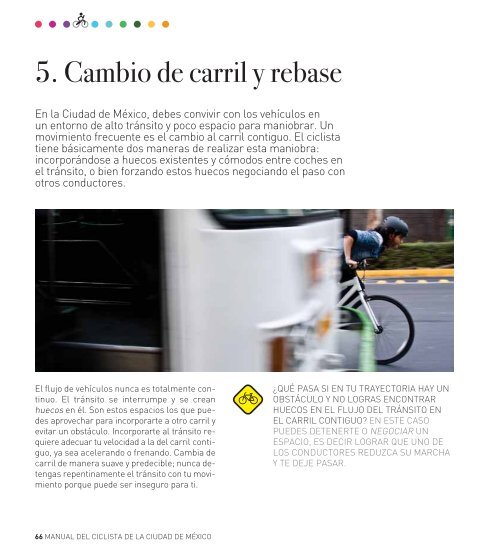Create successful ePaper yourself
Turn your PDF publications into a flip-book with our unique Google optimized e-Paper software.
5. Cambio de carril y rebase<br />
En la Ciudad de México, debes convivir con los vehículos en<br />
un entorno de alto tránsito y poco espacio para maniobrar. Un<br />
movimiento frecuente es el cambio al carril contiguo. El ciclista<br />
tiene básicamente dos maneras de realizar esta maniobra:<br />
incorporándose a huecos existentes y cómodos entre coches en<br />
el tránsito, o bien forzando estos huecos negociando el paso con<br />
otros conductores.<br />
El flujo de vehículos nunca es totalmente continuo.<br />
El tránsito se interrumpe y se crean<br />
huecos en él. Son estos espacios los que puedes<br />
aprovechar para incorporarte a otro carril y<br />
evitar un obstáculo. Incorporarte al tránsito requiere<br />
adecuar tu velocidad a la del carril contiguo,<br />
ya sea acelerando o frenando. Cambia de<br />
carril de manera suave y predecible; nunca detengas<br />
repentinamente el tránsito con tu movimiento<br />
porque puede ser inseguro para ti.<br />
66 <strong>MANUAL</strong> <strong>DEL</strong> <strong>CICLISTA</strong> DE LA CIUDAD DE MÉXICO<br />
¿QUÉ PASA SI EN TU TRAYECTORIA HAY UN<br />
OBSTÁCULO Y NO LOGRAS ENCONTRAR<br />
HUECOS EN EL FLUJO <strong>DEL</strong> TRÁNSITO EN<br />
EL CARRIL CONTIGUO? EN ESTE CASO<br />
PUEDES DETENERTE O NEGOCIAR UN<br />
ESPACIO, ES DECIR LOGRAR QUE UNO DE<br />
LOS CONDUCTORES REDUZCA SU MARCHA<br />
Y TE DEJE PASAR.


